2003 Oldsmobile Alero traction control
[x] Cancel search: traction controlPage 184 of 354
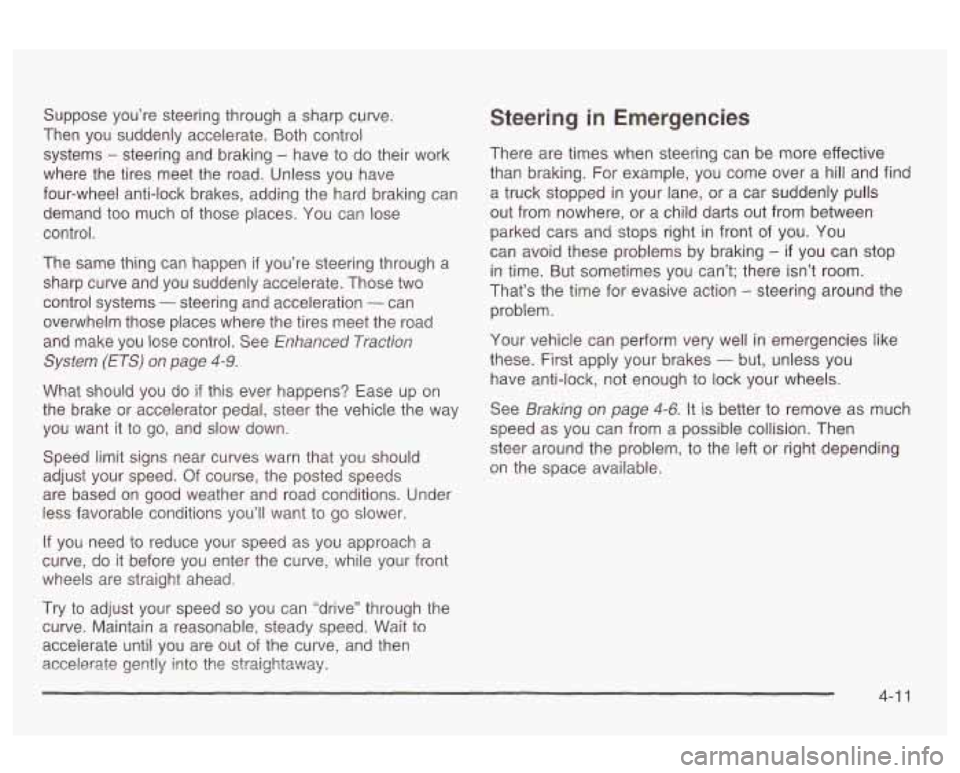
Suppose you’re steering through a sharp curve.
Then you suddenly accelerate. Both control
systems
- steering and braking - have to do their work
where the tires meet the road. Unless you have
four-wheel anti-lock brakes, adding the hard braking can
demand too much of those places. You can lose
control.
The same thing can happen
if you’re steering through a
sharp curve and you suddenly accelerate. Those two
control systems
- steering and acceleration - can
overwhelm those places where the tires meet the road
and make you lose control. See
Enhanced Traction
System (ETS) on page 4-9.
What should you do if this ever happens? Ease up on
the brake or accelerator pedal, steer the vehicle the way
you want it to go, and slow down.
Speed limit signs near curves warn that you should
adjust your speed. Of course, the posted speeds
are based on good weather and road conditions. Under
less favorable conditions you’ll want to go slower.
If you need to reduce your speed as you approach a
curve, do it before you enter the curve, while your front
wheels are straight ahead.
Try to adjust your speed so you can “drive” through the
curve. Maintain a reasonable, steady speed. Wait to
accelerate until you are out of the curve, and then
accelerate gently into the straightaway.
Steering in Emergencies
There are times when steering can be more effective
than braking. For example, you come over a
hill and find
a truck stopped in your lane, or a car suddenly pulls
out from nowhere, or a child darts out from between
parked cars and stops right
in front of you. You
can avoid these problems by braking
- if you can stop
in time. But sometimes you can’t; there isn’t room.
That’s the time for evasive action
- steering around the
problem.
Your vehicle can perform very well in emergencies like
these. First apply your brakes
- but, unless you
have anti-lock, not enough to lock your wheels.
See
Braking on page 4-6. It is better to remove as much
speed as you can from a possible collision. Then
steer around the problem, to the left or right depending
on the space available.
Page 187 of 354
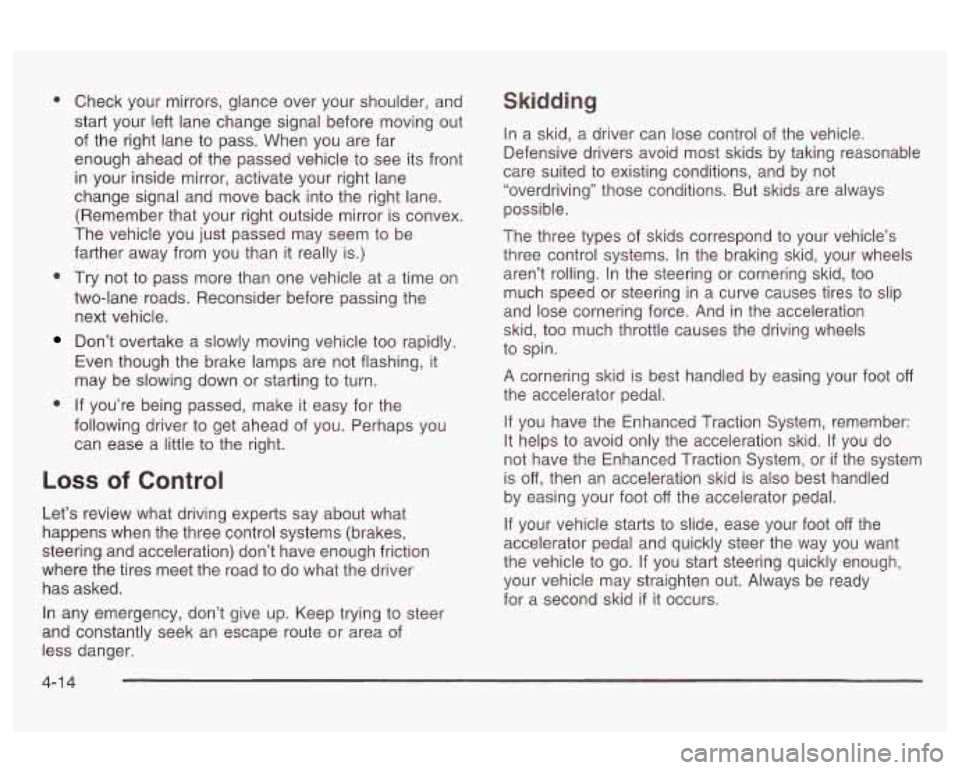
Check your mirrors, glance over your shoulder, and
start your left lane change signal before moving out
of the right lane to pass. When you are far
enough ahead of the passed vehicle to see its front
in your inside mirror, activate your right lane
change signal and move back into the right lane.
(Remember that your right outside mirror is convex.
The vehicle you just passed may seem to be
farther away from you than it really is.)
Try not to pass more than one vehicle at a time on
two-lane roads. Reconsider before passing the
next vehicle.
Don’t overtake a slowly moving vehicle too rapidly.
Even though the brake lamps are not flashing, it
may be slowing down or starting to turn.
If you’re being passed, make it easy for the
following driver to get ahead of you. Perhaps you
can ease a little to the right.
Loss of Control
Let’s review what driving experts say about what
happens when the three control systems (brakes,
steering and acceleration) don’t have enough friction
where the tires meet the road to do what the driver
has asked.
Skidding
In a skid, a driver can lose control of the vehicle.
Defensive drivers avoid most skids by taking reasonable
care suited to existing conditions, and by not
“overdriving” those conditions. But skids are always
possible.
The three types of skids correspond to your vehicle’s
three control systems. In the braking skid, your wheels
aren’t rolling. In the steering or cornering skid, too
much speed or steering in a curve causes tires to slip
and lose cornering force. And in the acceleration
skid, too much throttle causes the driving wheels
to spin.
A cornering skid is best handled by easing your foot off
the accelerator pedal.
If you have the Enhanced Traction System, remember:
It helps to avoid only the acceleration skid. If you do
not have the Enhanced Traction System, or
if the system
is
off, then an acceleration skid is also best handled
by easing your foot
off the accelerator pedal.
If your vehicle starts to slide, ease your foot
off the
accelerator pedal and quickly steer the way you want
the vehicle to go.
If you start steering quickly enough,
your vehicle may straighten out. Always be ready
for a second skid
if it occurs.
In any emergency, don’t give up. Keep trying to steer
and constantly seek an escape route
or area of
less danger.
4-1 4
Page 188 of 354

Of course, traction is reduced when water, snow, ice, Driving at Night
gravel or other material is on the road. For safety, you’ll
want to slow down and adjust your driving to these
conditions. It is important to slow down on slippery
surfaces because stopping distance will be longer and
vehicle control more limited.
While driving on a surface with reduced traction, try
your best to avoid sudden steering, acceleration
or braking (including engine braking by shifting to a
lower gear). Any sudden changes could cause the tires
to slide. You may not realize the surface is slippery
until your vehicle is skidding. Learn to recognize warning
clues
- such as enough water, ice or packed snow
on the road to make a “mirrored surface”
- and slow
down when you have any doubt.
If you have the anti-lock braking system, remember: It
helps avoid only the braking skid.
If you do not have
anti-lock, then in a braking skid (where the wheels are
no longer rolling), release enough pressure on the
.A
brakes to get the wheels rolling again. This restores
steering control. Push the brake pedal down steadily Night driving is more dangerous than day driving.
are rolling, you will have steering control. impaired
- by alcohol or drugs, with night vision
... Le- ..-.. Le..- A- -Le- -..AA--l.. A- I--- ^^ IL- ... L--l- VVI IGfI YUU I IaVG LU
31Up 3UUUGI Ily. fi3 IUI IY 63 11 It; VVI lGGl3 An,-, rnmpnn ia- thrrt a-nmn AriItnrp -srn l;i,nlt, tn hn VI Ib IbU.2WI I 1.2 LI IUC .2VIII~ UIIVbl.2 UlCI III\bIy cv Ub
problems, or by fatigue.
4-1 5
Page 272 of 354
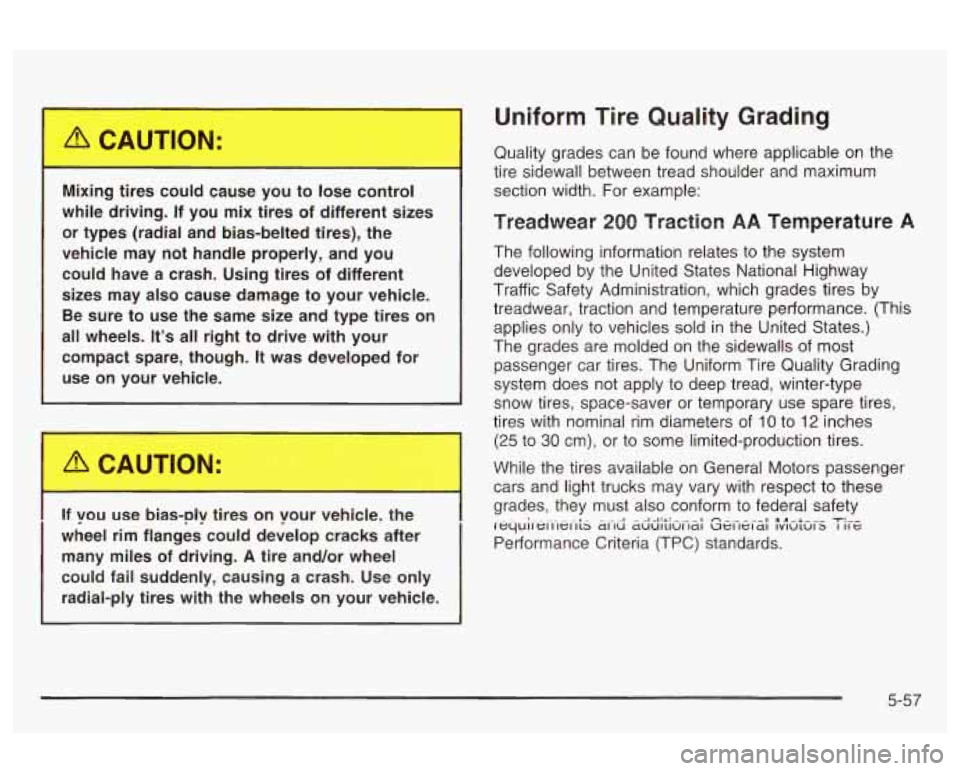
Uniform Tire Quality Grading
Mixing tires could cause you to lose control
while driving. If you mix tires of different sizes or types (radial and bias-belted tires), the
vehicle may not handle properly, and you could have a crash. Using tires
of different
sizes may also cause damage to your vehicle.
Be sure to use the same size and type tires on
all wheels.
It's all right to drive with your
compact spare, though.
It was developed for
use on your vehicle.
I If you use bias-ply tires on your vehicle. the I
wheel rim flanges could develop cracks after
many miles of driving.
A tire and/or wheel
could fail suddenly, causing a crash. Use only
radial-ply tires with the wheels on your vehicle. Quality grades can
be found where applicable on the
tire sidewall between tread shoulder and maximum
section width. For example:
Treadwear 200 Traction AA Temperature A
The following information relates to the system
developed by the United States National Highway
Traffic Safety Administration, which grades tires by
treadwear, traction and temperature performance. (This
applies only to vehicles sold in the United States.)
The grades are molded on the sidewalls of most
passenger car tires. The Uniform Tire Quality Grading
system does not apply to deep tread, winter-type
snow tires, space-saver or temporary use spare tires,
tires with nominal rim diameters of 10 to 12 inches
(25 to
30 cm), or to some limited-production tires.
While the tires available
on General Motors passenger
cars and light trucks may vary with respect to these
grades, they must also conform to federal safety
Performance Criteria (TPC) standards.
,t=yuj,.e!i-l-,-i-lis &;-,d dddiiisi-,a; &-,erd; ;";otsrs TiTG
5-57
Page 273 of 354

Treadwear
The treadwear grade is a comparative rating based on
the wear rate of the tire when tested under controlled
conditions on a specified government test course.
For example, a tire graded
150 would wear one and
a half
(1.5) times as well on the government course as
a tire graded
100. The relative performance of tires
depends upon the actual conditions of their use,
however, and may depart significantly from the norm
due
to variations in driving habits, service practices and
differences in road characteristics and climate.
Traction - AA, A, B, C
The traction grades, from highest to lowest, are AA, A,
B, and C. Those grades represent the tire’s ability
to stop on wet pavement as measured under controlled
conditions on specified government test surfaces of
asphalt and concrete.
A tire marked C may have poor
traction performance. Warning: The traction grade
assigned
to this tire is based on straight-ahead braking
traction tests, and does not include acceleration,
cornering, hydroplaning, or peak traction characteristics.
Temperature - A, B, C
The temperature grades are A (the highest), B, and C,
representing the tire’s resistance to the generation
of heat and its ability
to dissipate heat when tested
under controlled conditions on a specified indoor
laboratory test wheel. Sustained high temperature can cause
the material of the tire to degenerate and reduce
tire life, and excessive temperature can lead
to
sudden tire failure. The grade C corresponds to a level
of performance which all passenger car tires must
meet under the Federal Motor Vehicle Safety Standard
No. 109. Grades B and A represent higher levels of
performance on the laboratory test wheel than the
minimum required by law.
Warning: The temperature grade for this tire is
established for a tire that is properly inflated and not
overloaded. Excessive speed, underinflation, or
excessive loading, either separately or in combination,
can cause heat buildup and possible tire failure.
Wheel Alignment and Tire Balance
The wheels on your vehicle were aligned and balanced
carefully at the factory
to give you the longest tire life
and best overall performance.
Scheduled wheel alignment and wheel balancing are not needed. However,
if you notice unusual tire wear or
your vehicle pulling one way
or the other, the alignment
may need to be reset. If you notice your vehicle
vibrating when driving on a smooth road, your wheels
may need to be rebalanced.
5-58
Page 275 of 354
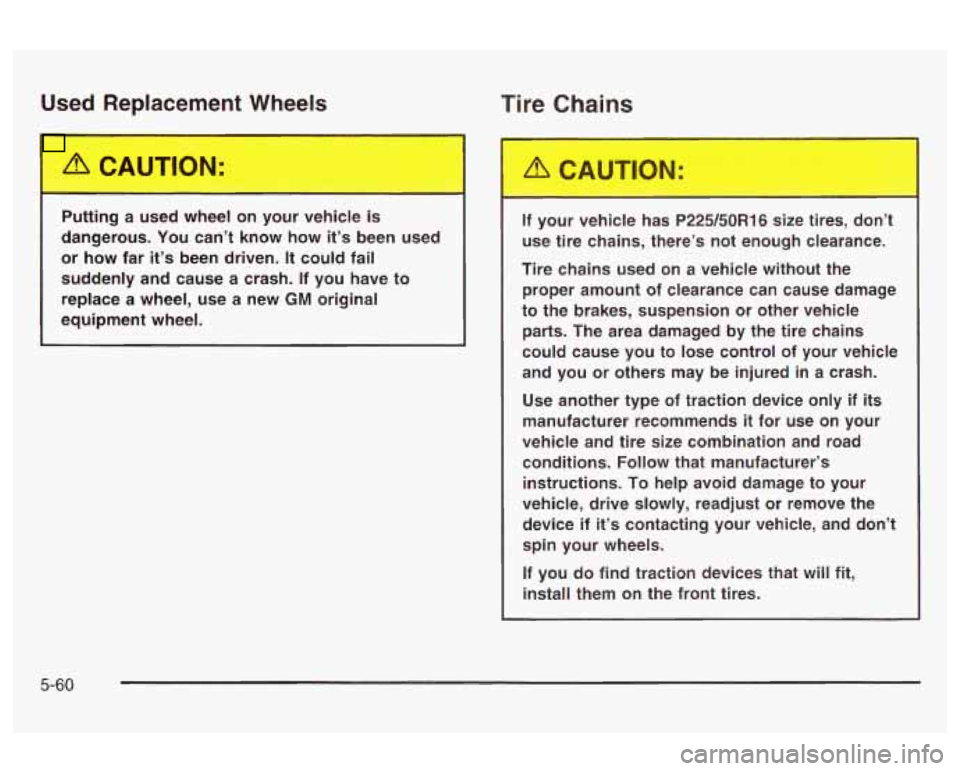
Used Replacement Wheels
- wmmu
I
Tire Chains
Putting a used wheel on your vehicle is
dangerous. You can’t know how
it’s been used
or how far
it’s been driven. It could fail
suddenly and cause a crash. If you have to replace a wheel, use a new
GM original
equipment wheel.
I
If your ve :le s FLL ;OR16 re tires, ,,n’t
use tire chains, there’s not enough clearance.
Tire chains used on a vehicle without the
proper amount of clearance can cause damage
to the brakes, suspension or other vehicle
parts. The area damaged by the tire chains
could cause you to lose control of your vehicle
and you or others may
be injured in a crash.
Use another type of traction device only
if its
manufacturer recommends
it for use on your
vehicle and tire size combination and road
conditions. Follow that manufacturer’s
instructions. To help avoid damage to your
vehicle, drive slowly, readjust or remove the device if it’s contacting your vehicle, and don’t spin your wheels.
If you do find traction devices that will
fit,
install them on the front tires.
5-60
Page 340 of 354
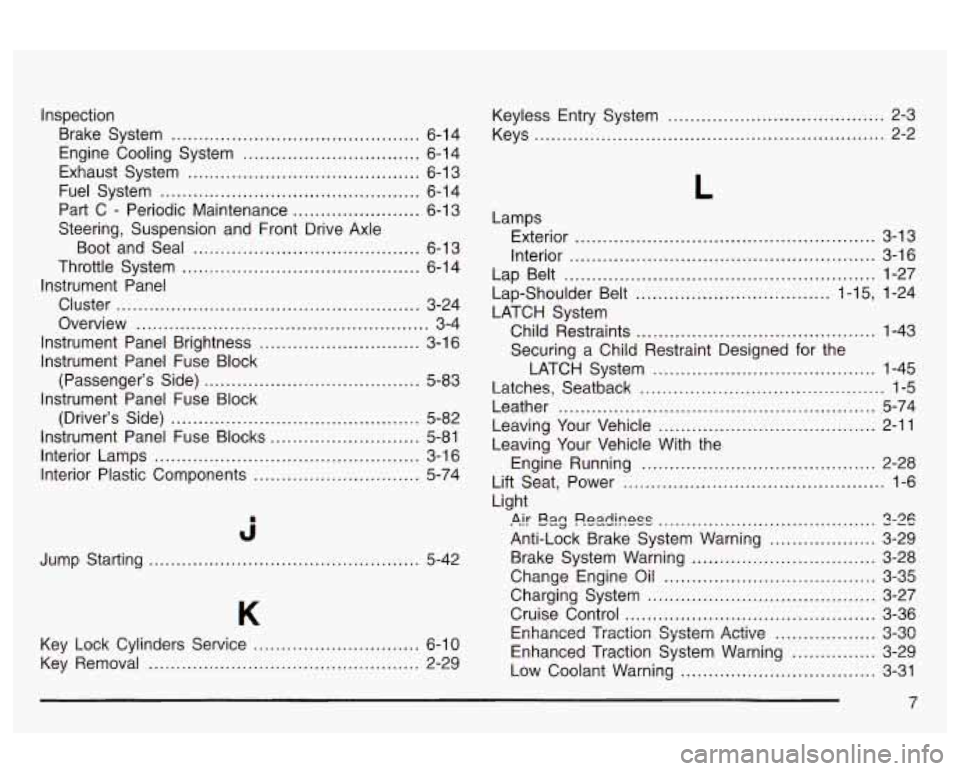
Inspection Brake System
............................................. 6-14
Engine Cooling System
................................ 6-14
Fuel System
............................................... 6-14
Part C
. Periodic Maintenance ....................... 6-13
Steering. Suspension and Front Drive Axle
Boot and Seal
......................................... 6-1 3
Throttle System
.................................... 6-1 4
Cluster
....................................................... 3-24
Overview
..................................................... 3-4
Instrument Panel Brightness
............................. 3-1 6
Instrument Panel Fuse Block
(Passenger's Side)
....................................... 5-83
instrument Panel Fuse Block
(Driver's Side)
............................................. 5-82
Instrument Panel Fuse Blocks
........................... 5-81
Exhaust System
.......................................... 6-13
Instrument Panel
Interior Lamps
................................................ 3-16
Interior Plastic Components
.............................. 5-74
J
Jump Starting ................................................. 5-42
Key Lock Cylinders Service
.............................. 6-10
Key Removal
................................................. 2-29 Keyless
Entry System
....................................... 2-3
Keys
............................................................... 2-2
L
Lamps
Exterior
............ .... ........ 3-13
Interior
....................................................... 3-16
Lap Belt
........................................................ 1-27
Lap-Shoulder Belt
................................... 1.15. 1-24
LATCH System Child Restraints
........................................... 1-43
Securing a Child Restraint Designed for the
LATCH System
........................................ 1-45
Latches,
Seatback ............................................ 1-5
Leather ......................................................... 5-74
Leaving Your Vehicle
....................................... 2-11
Leaving Your Vehicle With the
Engine Running
.......................................... 2-28
Lift Seat, Power
....................... ......... 1-6
Light
................................... 3-26
Anti-Lock Brake System Warning ................... 3-29
Brake System Warning
................................. 3-28
Change Engine Oil
...................................... 3-35
Charging System
......................................... 3-27
Cruise Control
............................................. 3-36
Enhanced Traction System Warning
............... 3-29
Low Coolant Warning
................................... 3-31
. A-ir -"a Ran Rnadinncc .V UU ... YYY
LI c+,,,, I talIbGd T;actior; System Active J-JO QQ ..................
7
Page 346 of 354
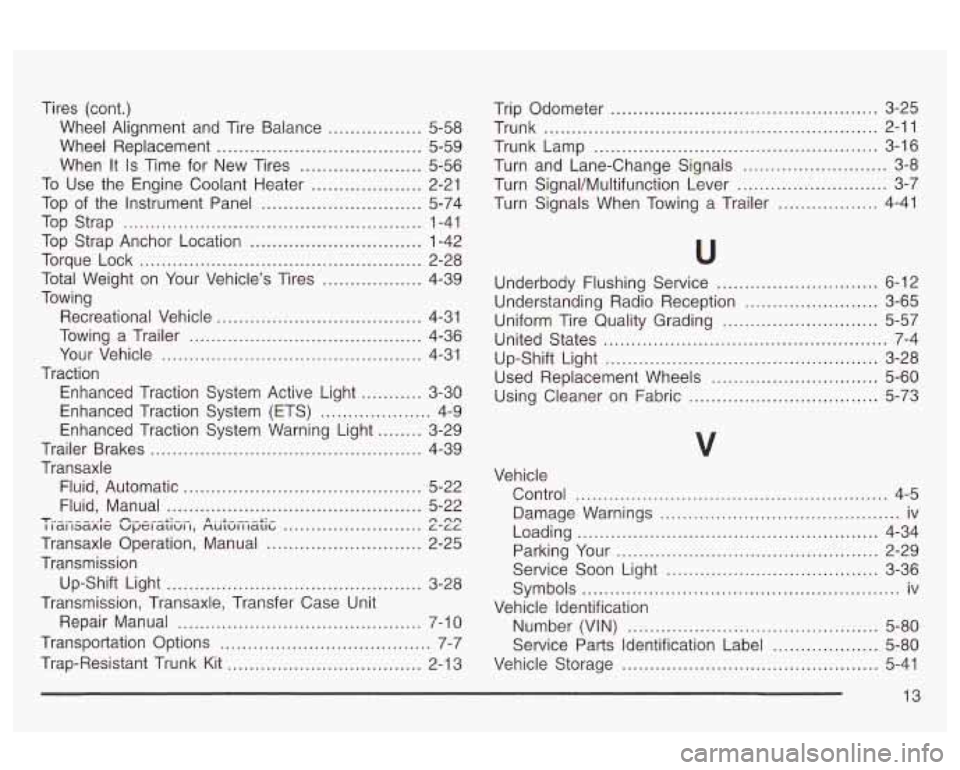
Tires (cont.) Wheel Alignment and Tire Balance
................. 5-58
Wheel Replacement
..................................... 5-59
When It
Is Time for New Tires ...................... 5-56
To Use the Engine Coolant Heater
.................... 2-21
Top of the Instrument Panel
............................. 5-74
Top Strap
...................................................... 1-41
Top Strap Anchor Location
............................... 1-42
Torque Lock
................................................... 2-28
Total Weight on Your Vehicle’s Tires
.................. 4-39
Towing Recreational Vehicle
..................................... 4-31
Towing a Trailer
.......................................... 4-36
Your Vehicle
............................................... 4-31
Traction Enhmced Traction Systerr; Active Light
........... 3-30
Enhanced Traction System Warning Light
........ 3-29
Enhanced
Traction System (ETS)
.................... 4-9
Trailer Brakes
................................................. 4-39
Transaxle Fluid, Automatic
........................................... 5-22
Fluid, Manual
.............................................. 5-22 T - - .. I - n- -.--a: - .- A . .I -.-- -L:- I I dl 13dAlt: Upel dllUl I, fiUlUl1 ldllb 6-66 A nA .........................
Transaxle Operation, Manual ............................ 2-25
Transmission Up-Shift Light
.............................................. 3-28
Transmission, Transaxle, Transfer Case Unit
Repair Manual
........................................ 7-10
Transportation Options
...................................... 7-7
Trap-Resistant Trunk Kit
................................... 2-1 3 Trip Odometer
.......... ........................... 3-25
Trunk
............................................................ 2-11
Turn and Lane-Change Signals
.......................... 3-8
Turn Signal/Multifunction Lever
........................... 3-7
Turn Signals When Towing a Trailer
.................. 4-41
Trunk Lamp
................................................... 3-16
Underbody Flushing Service
............................. 6-12
Understanding Radio Reception
........................ 3-65
Uniform Tire Quality Grading
............................ 5-57
United States
................................................... 7-4
Up-Shift Light
................................................. 3-28
Used Replacement Wheels
.............................. 5-60
using Cleaner on Fabric
.................................. 5-73
v
Vehicle
Control
........................... ..................... 4-5
Damage Warnings
........................................... iv
Loading
...................................................... 4-34
Service Soon Light
...................................... 3-36
Parking
Your
............................................... 2-29
Symbols
......................................................... iv
Vehicle Identification
Number (VIN)
............................................. 5-80
Service Parts Identification Label
................... 5-80
Vehicle Storage
.............................................. 5-41
13